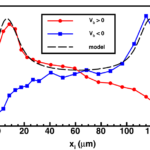
EQE of semiconducting polymer (P3HT) as a function of illumination position between coplanar metal electrodes.
We have performed a systematic study of dependence of time-resolved photocurrent on the point of charge excitation within the organic semiconductor channel formed by two coplanar metal electrodes. The results confirm that spatial variation of electric field between the electrodes crucially determines transport of photogenerated charge carriers through the organic layer. Time-of-flight measurements of photocurrent demonstrate that the transit time of photogenerated charge carrier packets drifting between the two electrodes decreases with increasing travelling distance. Such counterintuitive result cannot be reconciled with the spatial distribution of electric field between coplanar electrodes, alone. It is also in contrast to expected role of space-charge screening of external electric field. Supported by Monte Carlo simulations of hopping transport in disordered organic semiconductor layer, we submit that the space-charge screens the external electric field and captures slower charge carriers from the photogenerated charge carrier packet. The remaining faster carriers, exhibit velocity distribution with significantly higher mean value and shorter transit time. The work is published in Organic Electronics.
